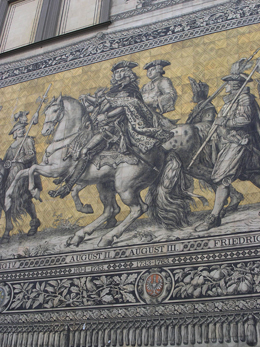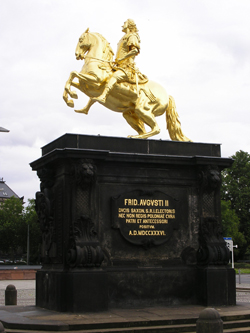|
 Augustus II the Strong,
the Elector of Saxony (1694-1733) and the King
of Poland (1697-1706, 1709-1733). His
great physical strength earned him the by-name
"the Strong". Augustus was a son of
John George III of Saxony
and
Princess Anne Sophie of Denmark.
Following the death of his elder brother
John George IV
he became Elector of Saxony in 1694.
Following the death of Polish
King Jan III Sobietski
and turning into Catholicism he was elected King
of the Polish-Lithuanian Commonweal in 1697.
For many years he was involved into
the war of the Holy
League against Ottoman Empire and finally
succeeded in signing the Treaty of
Karlowitz (1699). When Charles XI of Sweden died in 1697, he was succeeded
to the throne by his fifteen-year-old son
Charles. This was seen as an opportunity
by Russia, Denmark and Poland-Saxony
to regain their lands captured
by Sweden in XVI century. After forming
an alliance with Denmark and Poland-Saxony
and making peace with Ottoman Empire
Russian tsar Peter I declared war
on Sweden in 1700.
Augustus II the Strong,
the Elector of Saxony (1694-1733) and the King
of Poland (1697-1706, 1709-1733). His
great physical strength earned him the by-name
"the Strong". Augustus was a son of
John George III of Saxony
and
Princess Anne Sophie of Denmark.
Following the death of his elder brother
John George IV
he became Elector of Saxony in 1694.
Following the death of Polish
King Jan III Sobietski
and turning into Catholicism he was elected King
of the Polish-Lithuanian Commonweal in 1697.
For many years he was involved into
the war of the Holy
League against Ottoman Empire and finally
succeeded in signing the Treaty of
Karlowitz (1699). When Charles XI of Sweden died in 1697, he was succeeded
to the throne by his fifteen-year-old son
Charles. This was seen as an opportunity
by Russia, Denmark and Poland-Saxony
to regain their lands captured
by Sweden in XVI century. After forming
an alliance with Denmark and Poland-Saxony
and making peace with Ottoman Empire
Russian tsar Peter I declared war
on Sweden in 1700.
 It was in this way the twenty-one-year Great
Northern war began.
It was in this way the twenty-one-year Great
Northern war began.
But young Swedish king proved an
able gifted military commander. First he
succeeded in forcing the Denmark
out of the war and then
he defeated Russian army at Narva (1700).
After that he focused on the struggle against
the King of Poland. The aim of this
campaign was to depose
Augustus II. Charles XII won the battles of
Riga (1701), Kliszow (1702), Pulutsk (1703),
Fraustadt (1706). On September,
1 1706, Swedish king invaded Saxony,
dethroned Augustus and placed
Stanislaus Leszczynski on the
Polish throne by the Treaty of Altranstadt.
Meanwhile Tsar Peter I had rebuilt Russian army
following the western pattern.
 At the Battle of Poltava he defeated Swedes
and put an end to the Swedish Empire.
Soon after that the weak Polish-Lithuanian
Commonwealth became fully dependent of Russia.
At the Battle of Poltava he defeated Swedes
and put an end to the Swedish Empire.
Soon after that the weak Polish-Lithuanian
Commonwealth became fully dependent of Russia.
The Battle of Poltava secured
Augustus IIís return to the Polish throne.
He failed to reestablish an
absolute monarchy in the
Polish-Lithuanian Commonwealth facing
with opposition from the nobility.
Augustus II was well known among his
contemporaries as a big connoisseur of
fine arts and architecture.
During his reign many palaces in baroque
style with unique art collections were built in
Dresden.
Being a big fond of
porcelain he founded the manufacture of fine
porcelain
at the Meissen and Dresden. Augustus died in
1733. His eldest son, Frederick Augustus II of
Saxony, succeed him to the
Polish throne as
Augustus III of Poland.
|
 History
History
 Dates and events
Dates and events
 Persons
Persons
 Poltava
Poltava
 Sights
Sights
 Photo gallery
Photo gallery
 Maps
Maps
 Virtual Museum
Virtual Museum
 Armament
Armament
 Uniforms
Uniforms
 Coins and medals
Coins and medals
 Flags
Flags
 Paintings
Paintings
 Poltava photographs
Poltava photographs
 News
News
 About us
About us
 Acknowledgments
Acknowledgments
 Main page
Main page
 top
top ...back
...back  History
History
 Dates and events
Dates and events
 Persons
Persons
 Poltava
Poltava
 Sights
Sights
 Photo gallery
Photo gallery
 Maps
Maps
 Virtual Museum
Virtual Museum
 Armament
Armament
 Uniforms
Uniforms
 Coins and medals
Coins and medals
 Flags
Flags
 Paintings
Paintings
 Poltava photographs
Poltava photographs
 News
News
 About us
About us
 Acknowledgments
Acknowledgments
 Main page
Main page